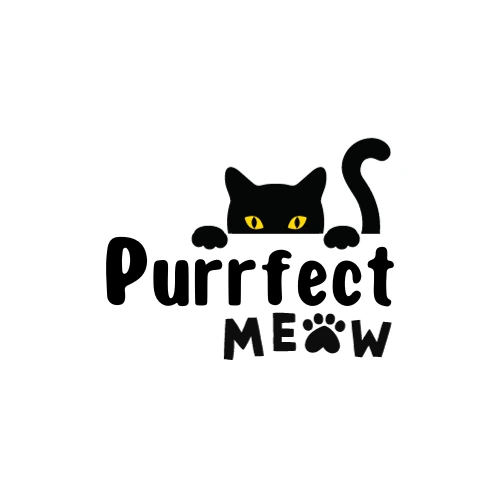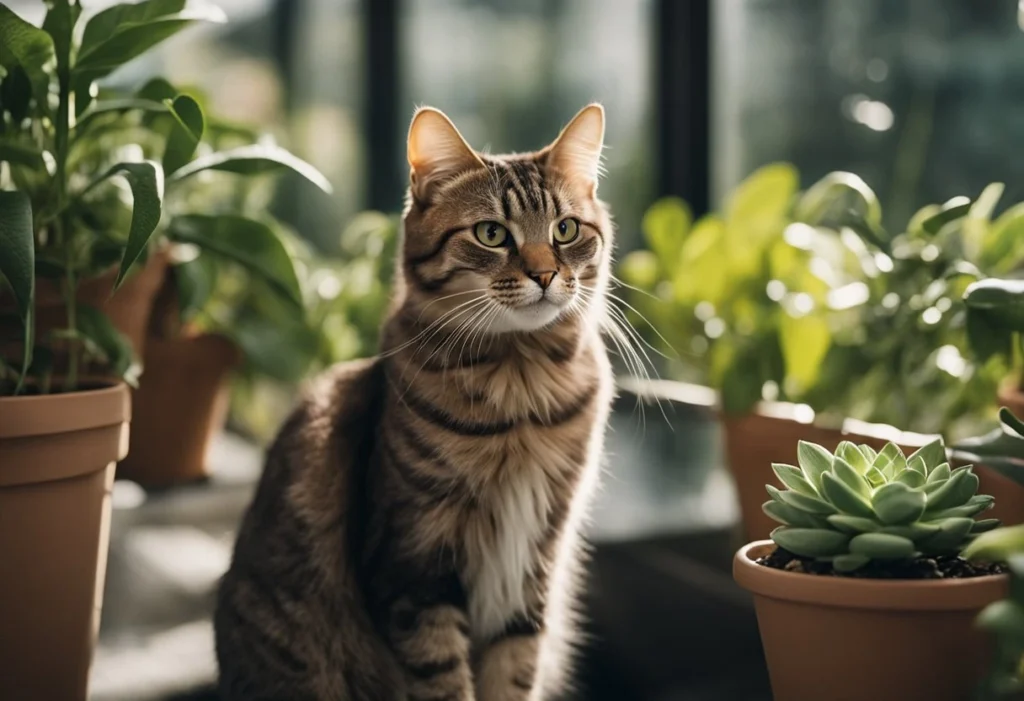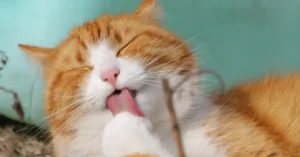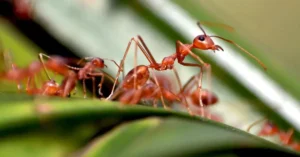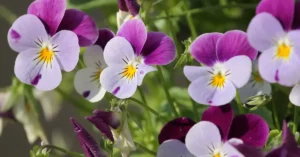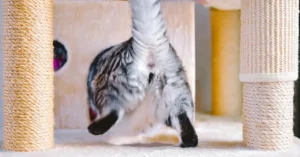Are you a cat parent who loves houseplants but can’t seem to keep them safe from your furry friend? We know the struggle! As much as we adore our feline companions, their curious nature often leads them to nibble on our indoor plants, which can be dangerous for their health. But worry not, because we’ve got you covered with some effective tips on how to keep cats from eating plants.
First and foremost, it’s crucial to understand that cats are natural climbers and love exploring their surroundings. Therefore, it’s essential to place your houseplants out of their reach. You can either hang them from the ceiling or place them on high shelves. However, if you have a particularly agile cat, you may need to get creative and install barriers around your plants to keep them away.
Another way to deter your cat from eating plants is by using cat-safe repellents. Some cats are repelled by certain smells, such as citrus or mint, so you can try spraying a mixture of water and essential oils around your plants. However, be sure to use only cat-safe essential oils, as some can be toxic to felines. Additionally, you can sprinkle some cayenne pepper or mustard powder around your plants, as cats dislike the taste and smell.
Understanding Cat Behavior
As cat owners, we all know how much our feline friends love to explore and play with anything that catches their attention. Unfortunately, this often includes our beloved houseplants. In this section, we will explore the reasons behind why cats chew on leaves and how to keep cats from eating plants.
The Curiosity of Cats and Plants
Cats are naturally curious creatures, and plants provide an interesting and stimulating environment for them to explore. They are attracted to the texture, smell, and taste of the leaves, which can be irresistible to them. It is important to note that not all cats are the same, and some may be more interested in plants than others.
Why Cats Chew on Leaves
Cats may chew on leaves for several reasons, including boredom, stress, or medical issues. In some cases, cats may be trying to supplement their diet with additional nutrients found in plants. However, most of the time, cats chew on leaves simply because they enjoy it.
Boredom and Hunting Instincts
Cats are natural hunters, and they have a strong instinct to stalk and pounce on prey. When they are bored or not getting enough exercise, they may turn to chewing on plants as a way to satisfy their hunting instincts. Providing your cat with plenty of toys and playtime can help reduce their boredom and prevent them from turning to your plants for entertainment.
To understand why cats chew on leaves is the first step in preventing them from eating your plants. By providing your cat with a stimulating environment, plenty of exercise, and safe alternatives to chew on, you can keep your plants and your cat healthy and happy.
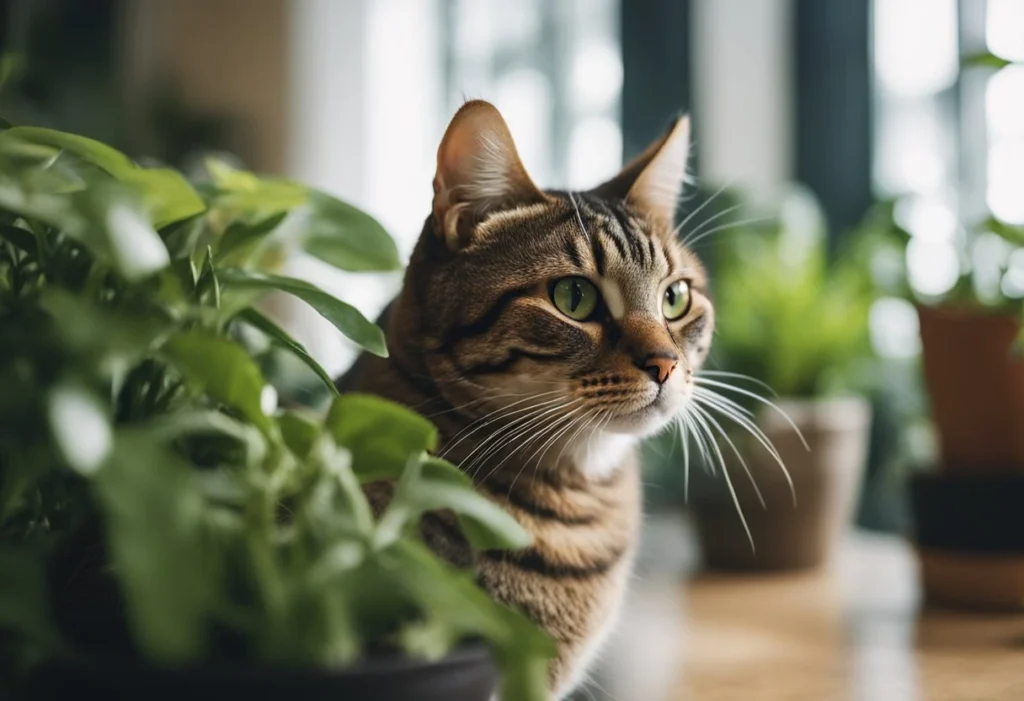
Identifying Risky Plants
As cat owners, we know that our feline friends love to nibble on plants. However, not all plants are safe for cats to eat. In fact, some plants can be toxic and even deadly. In this section, we will help you identify risky plants and provide safe alternatives for your furry friend.
Common Toxic Plants to Avoid
It’s important to be aware of the plants that are toxic to cats. Here are some common plants that you should avoid having in your home:
| Plant Name | Toxic Part | Symptoms |
|---|---|---|
| Lily | All parts | Vomiting, lethargy, loss of appetite, kidney failure |
| Aloe Vera | Leaves | Vomiting, lethargy, diarrhea |
| Pothos | Leaves, stems | Oral irritation, vomiting, difficulty swallowing |
| Sago Palm | Seeds, leaves | Vomiting, diarrhea, liver failure |
| Dieffenbachia | Leaves, stems | Oral irritation, vomiting, difficulty swallowing |
These are just a few examples of toxic plants. If you’re unsure if a plant is safe for your cat, it’s best to err on the side of caution and keep it out of reach.
Safe Alternatives: Non-Toxic Plants
Thankfully, there are plenty of non-toxic plants that you can safely have in your home. Here are a few examples:
- Spider plant
- Boston fern
- Bamboo palm
- African violet
- Christmas cactus
Not only are these plants safe for cats, but they also add a touch of greenery to your home. If you’re looking for more options, be sure to check out the ASPCA’s list of plants that are safe for cats.
By being aware of which plants are toxic and which are safe, you can create a cat-friendly environment that both you and your furry friend can enjoy.
Preventive Strategies
As cat owners, we know how much our feline friends love to nibble on plants. However, this can be harmful to their health and the plants themselves. In this section, we’ll discuss some preventive strategies to keep your cats from eating plants and ensure a happy and healthy home for you and your furry friend.
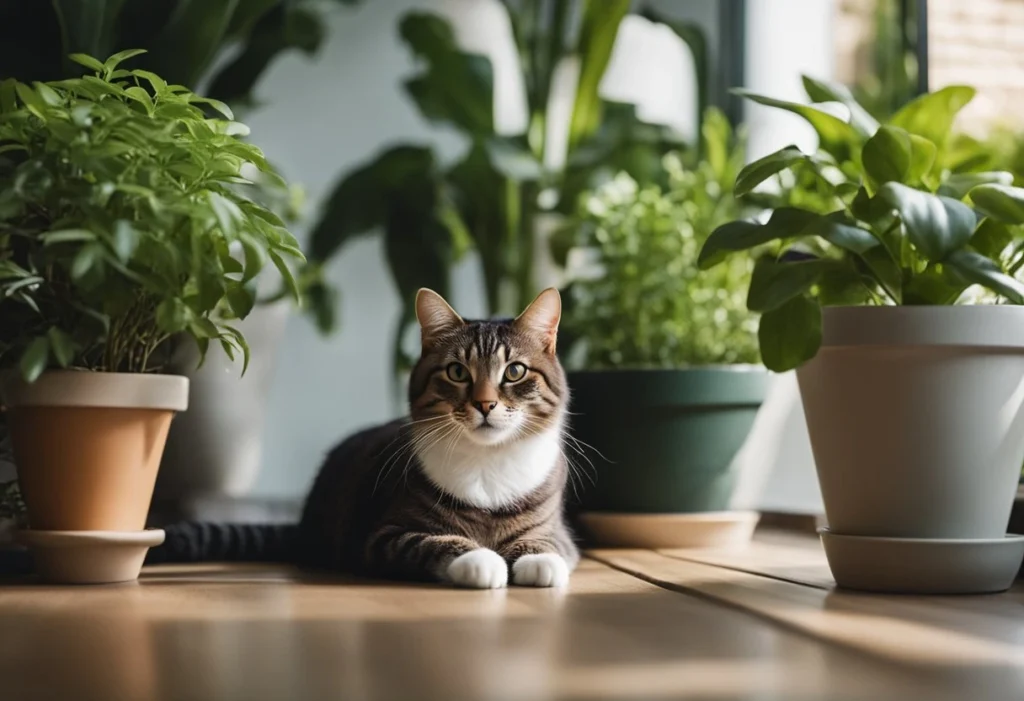
Creating a Cat-Friendly Garden
One way to prevent cats from eating plants is by creating a cat-friendly garden. This involves planting cat-safe plants that are non-toxic to cats and have a texture that cats don’t find appealing. Some examples of cat-safe plants include catnip, catmint, and valerian. You can also add some texture to your garden by planting ornamental grasses or cacti, which cats tend to avoid.
Effective Repellents and Deterrents
Another way to keep your cats from eating plants is by using effective repellents and deterrents. There are many natural and commercial products available that can help discourage cats from nibbling on your plants. Some natural repellents include citrus, vinegar, and coffee grounds, which can be sprinkled around the base of your plants. Commercial products include motion-activated sprays that startle cats and ultrasonic devices that emit high-frequency sounds that cats find unpleasant.
Physical Barriers and Plant Placement
Physical barriers and plant placement can also be effective in keeping your cats from eating plants. Hanging plants can be placed out of reach of your cats, and plants can be placed in areas that are difficult for your cats to access, such as high shelves or behind furniture. You can also create physical barriers using materials such as chicken wire or mesh netting to protect your plants.
By implementing these preventive strategies, you can keep your cats from eating plants and ensure a safe and healthy environment for both you and your furry companions.
Natural Solutions
If you’re looking for natural ways to keep your cats from eating your plants, we’ve got you covered! Here are some effective and safe methods that you can try:
Using Scents Cats Dislike
Cats have a strong sense of smell, and there are certain scents that they don’t like. One of the most effective scents is citrus. Cats dislike the smell of citrus fruits like lemons and oranges, so you can use them to your advantage. You can place citrus peels around your plants or use citrus-scented sprays to keep your cats away.
Another scent that cats dislike is lavender. You can place lavender plants near your other plants to repel your cats. Rosemary and lemon thyme are also effective at keeping cats away.
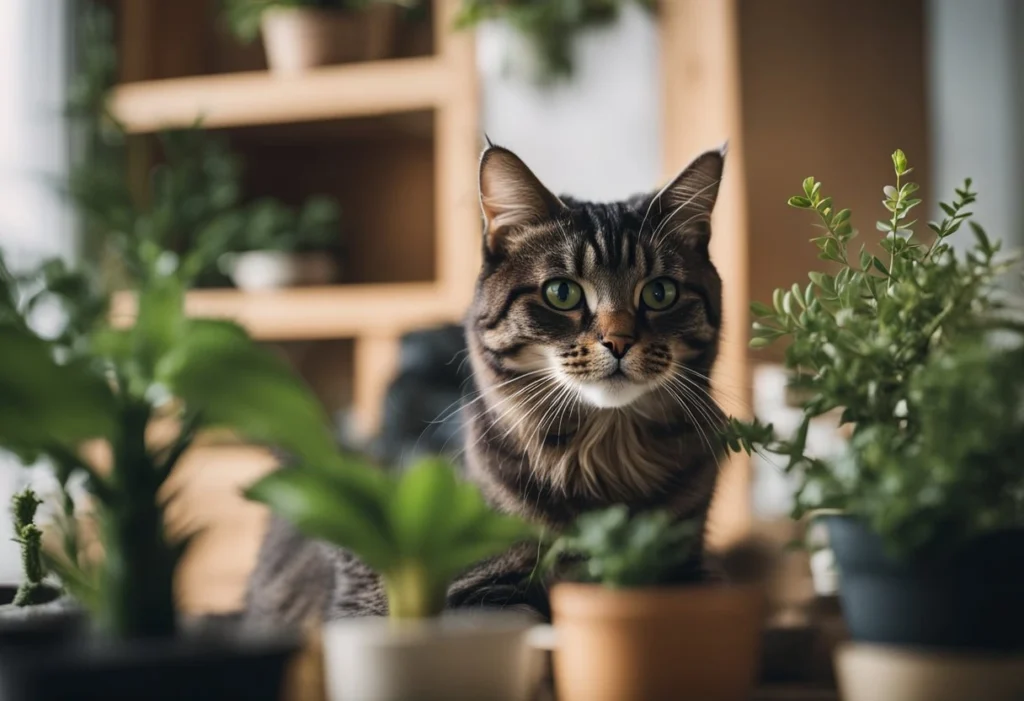
Homemade Sprays and Solutions
You can also make your own sprays and solutions to keep your cats away from your plants. One of the most effective solutions is vinegar. You can mix equal parts of vinegar and water and spray it on your plants. Cats dislike the smell of vinegar, so they’ll stay away.
You can also use essential oils to make your own cat repellent spray. Mix a few drops of essential oils like eucalyptus, peppermint, or lemon with water and spray it on your plants. Be sure to test the spray on a small area first to make sure it doesn’t harm your plants.
Alternative Distractions
As much as we would like to keep our feline friends away from our plants, it’s important to remember that cats are naturally curious creatures. Instead of punishing them for their behavior, we can redirect their attention to alternative distractions that are more appropriate for them.
Engaging Toys and Activities
One way to distract your cat from your plants is to provide them with engaging toys and activities. Cats love to play, and having toys around can keep them entertained for hours on end. Toys like balls, strings, and feather wands are great options to keep your cat occupied. You can also try puzzle toys that require your cat to work for their treats, which can keep them busy for even longer.
Cat Grass and Safe Chewables
Another way to distract your cat from your plants is to provide them with safe chewables. Cat grass is a great option that can satisfy your cat’s natural urge to chew on plants. It’s safe for them to eat, and it can also help with their digestion. You can also try other safe chewables like wheat, rye, or barley grass. These can be found at most pet stores, or you can even grow them yourself.
It’s important to remember that cats are individuals, and what works for one cat may not work for another. It may take some trial and error to find the right toys and activities that your cat enjoys. But with a little patience and persistence, you can find the right distractions to keep your cat from eating your plants.
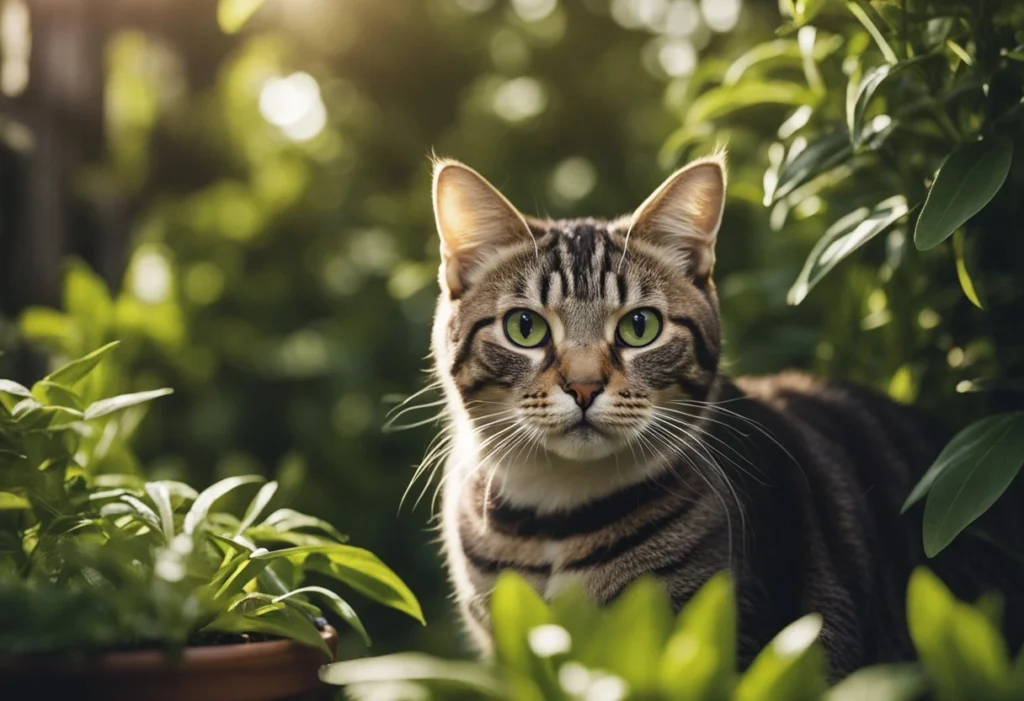
Training and Behavior Modification
As much as we love our cats, we can’t deny that they are natural-born hunters and curious creatures. This means that they are prone to nibbling on our houseplants, which can be dangerous for them. Luckily, there are several training and behavior modification techniques that we can use to keep our feline friends from eating our plants.
Positive Reinforcement Techniques
One of the most effective ways to train your cat to stop eating plants is through positive reinforcement. This involves rewarding your cat for exhibiting good behavior, such as ignoring the plants. You can use treats, toys, or verbal praise to reward your cat. It’s important to be consistent with your rewards and to avoid punishing your cat for bad behavior.
One way to use positive reinforcement is to create a designated space for your cat to play and explore. This can be a designated plant-free area, or you can provide your cat with their own plants to nibble on. This will help redirect their attention away from your plants.
Remote Punishment and Correction
Remote punishment and correction can also be effective in training your cat to stop eating plants. This involves using a device, such as a motion-activated spray or a noise-making device, to deter your cat from approaching the plants. These devices are designed to startle your cat and discourage them from approaching the plants.
It’s important to note that remote punishment and correction should only be used as a last resort and should never be used to harm or scare your cat. These devices should only be used in conjunction with positive reinforcement techniques to help reinforce good behavior.
Reducing Stress
It’s also important to consider your cat’s overall stress levels when trying to prevent them from eating plants. Stress can lead to increased anxiety and destructive behavior, such as plant nibbling. To reduce stress, make sure your cat has plenty of toys and playtime, a comfortable place to sleep, and access to fresh water and food.
Health Considerations
As much as we love our feline friends, we must ensure that they do not eat plants that could be harmful to their health. Understanding plant toxicity and digestion is crucial in preventing accidental ingestion. In this section, we will discuss the importance of being aware of poisonous plants and how to administer first aid in case of accidental ingestion.
Understanding Plant Toxicity and Digestion
Cats are obligate carnivores, which means that they require meat in their diet to survive. However, they may occasionally eat plants out of curiosity or boredom. It is essential to be aware of the plants that are toxic to cats, as ingestion can lead to vomiting, diarrhea, and even death. Some common poisonous plants include lilies, daffodils, and aloe vera.
It is also important to note that cats have a different digestive system than humans. They lack certain enzymes that are necessary for breaking down certain substances. For example, cats cannot metabolize caffeine and theobromine, which are found in chocolate and coffee. Consuming these substances can cause severe health problems, including seizures and heart failure.
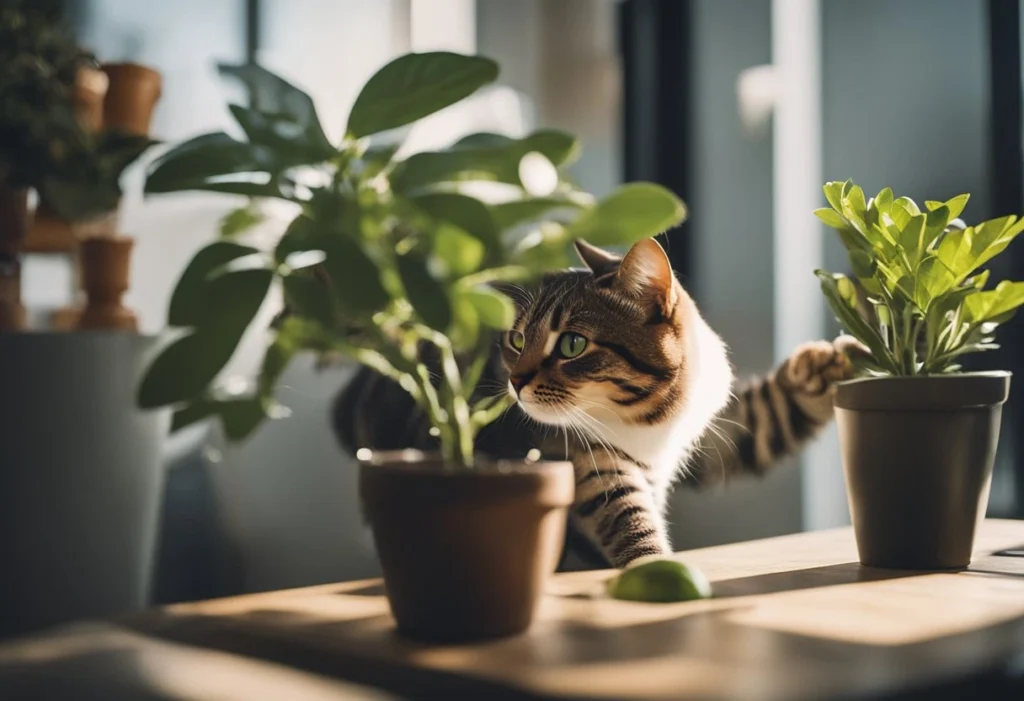
First Aid for Accidental Ingestion
If you suspect that your cat has ingested a poisonous plant, it is essential to seek veterinary assistance immediately. Do not wait for symptoms to appear, as some toxins can cause irreversible damage within hours.
In the meantime, you can administer first aid to your cat. If the plant was ingested recently, induce vomiting by giving your cat a teaspoon of hydrogen peroxide. If your cat is experiencing seizures or tremors, keep them calm and in a quiet, dark room until you can get them to the vet.
Our Thoughts About How to Keep Cats from Eating Plants
In our pursuit of cultivating a green oasis at home, we’ve encountered the delightful challenge of harmonizing our love for plants with the playful antics of our feline companions. It’s a juggling act that requires a touch of creativity and a lot of understanding.
We’ve learned that introducing cat-friendly alternatives is a game-changer. Catnip and wheatgrass, strategically placed, serve as enticing diversions, steering our curious cats away from the more delicate foliage. It’s like offering them a green playground of their own.
The aromatic approach has proven effective. Citrus peels or a hint of citrus-scented spray act as natural deterrents, creating a subtle barrier that our cats find less appealing. Our home now carries a refreshing hint of citrus, and our plants remain untouched.
Physical barriers, we’ve discovered, can be both functional and decorative. Placing decorative rocks or pinecones around the soil not only adds a touch of charm but also discourages our furry friends from digging in the dirt. It’s a win-win for aesthetics and plant protection.
Positive reinforcement has become a cornerstone of our strategy. When our cats exhibit disinterest in the plants, a few words of praise or a small treat create positive associations, reinforcing their good behavior. It’s a journey of mutual respect and shared space.
FAQ
Here are some frequently asked questions about how to keep cats from eating plants:
How do I get my cat to stop eating my plants?
There are several ways to get your cat to stop eating your plants. One way is to provide them with an alternative source of greens, such as cat grass. Cat grass is a safe and healthy option that will satisfy your cat’s craving for greenery. Another way is to use a deterrent spray that is safe for plants and cats. You can also try placing citrus peels or coffee grounds around the base of your plants, as cats tend to dislike these scents.
Does vinegar stop cats from eating plants?
While vinegar has been touted as a natural deterrent for cats, it is not always effective and can potentially harm your plants. Instead, try using a commercial deterrent spray that is specifically designed for cats and safe for plants. You can also try using double-sided tape or aluminum foil around the base of your plants, as cats tend to dislike the texture.
What is the best deterrent for cats eating plants?
The best deterrent for cats eating plants will vary depending on your cat’s preferences and behavior. Some cats are deterred by certain scents, while others are deterred by textures. Commercial deterrent sprays are a popular option, but you can also try using natural repellents such as citrus peels, coffee grounds, or even human hair. It’s important to choose a deterrent that is safe for both your cat and your plants.
If you also would like to know something about the 18 most popular cat breeds have a look at our article.
If you are interested in special breeds like the biggest House cat breed it would be a pleasure if you read our article.
What are your thoughts about the biggest house cat breed? Let us know in the comments.
